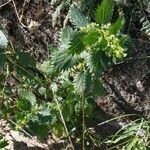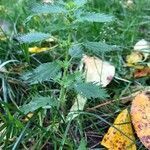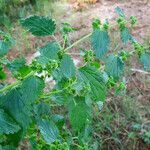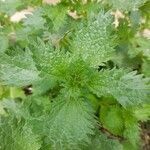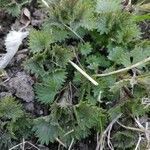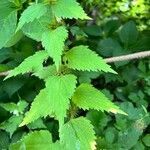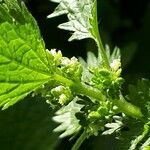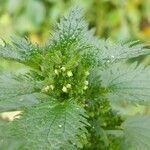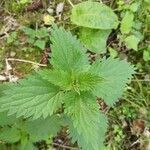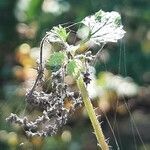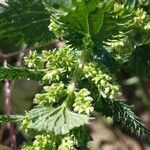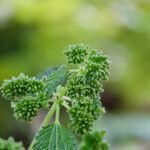Herbs annual. Stems branched, 10-60 cm tall, sparsely puberulent and somewhat densely armed with stinging hairs; lower internodes 4-7 cm, upper internodes 1-3 cm. Stipules free, narrowly triangular, 1-2.5 mm, ciliate; petiole 1-2.5 cm, puberulent, sparsely armed with stinging hairs; leaf blade broadly elliptic, sometimes ovate or obovate, 1.2-6 × 0.6-3 cm, 5-veined, often subglabrous except for sparse stinging hairs on both surfaces, base broadly cuneate or rounded, margin 6-11-dentate, apex obtuse-rounded; cystoliths punctiform, distinct adaxially. Inflorescences containing proximal female flowers and distal male flowers, spicate, 0.5-2.5 cm. Male flowers short pedicellate, in bud ca. 1.2 mm; perianth lobes connate 1/2 of length, puberulent. Female flowers: perianth lobes connate at base, dorsal-ventral lobes ovate, equaling achene, often with 1 stinging hair on dorsal rib, sparsely setulose along margin, lateral lobes ovate, ca. 5 times as small as others. Achene brownish gray, ovoid, compressed, 0.8 mm, verrucose, invested by persistent perianth lobes. Fl. May-Jul, fr. Aug-Sep.
Erect, ascending or procumbent annual herb up to 0.5 m high, sometimes profusely branched from base, monoecious. Stems with stiff hairs when young, later glabrescent; stinging hairs dense to sparse. Leaves elliptic, 22-45 x 18-28 mm, apical tooth as long as or longer than broad, margin with 9-13 pairs of long narrow teeth which are often trilobed, with stinging hairs scattered on upper surface and on veins of lower surface, with stiff hairs absent or sometimes a few present on young leaves; petiole (7-)30-50 mm long, with stinging and usually with stiff hairs; stipules narrowly lanceolate, ±1.5 x 0.5 mm, acute, pubescent. Inflorescence at first dense, later becoming lax, cylindrical, 5-20 x 3-5 mm, bisexual, with male and female flowers mixed, frequently with stinging and stiff hairs; peduncle short. Female flowers with hairs as in key, 1.75-2.0 mm long; pedicel with stinging and stiff hairs. Male flowers 0.8-1.0 mm in diameter; pedicel ±0.5 mm long. Achenes smooth or minutely punctate, pale ochre.
Monoecious annual herb to 60 (–90) cm high; mature leaves and stems mostly glabrous or nearly so between the stinging hairs. Leaves: lamina ovate to elliptic, deeply and narrowly incised (rarely doubly toothed), rounded, obtuse or less commonly acute apex, broadly cuneate at base, (1–) 3–6 cm long, (1–) 1.5–4.5 cm wide, discolorous with lower surface a paler green; lateral veins 4 or 5 pairs, the second pair reaching nearly to lamina apex, the last two pairs short, near apex; petiole to 5 cm long, the petiole of leaves towards base of plant (0.5–) 1–2 (–3) cm long and often at least (usually more than) half as long as lamina; stipules small, less than 5 mm long. Inflorescences paired, short spikes, bisexual, mostly shorter than petiole. Flowers subsessile, 1–2 mm long, c. 1 mm wide; males often at base of inflorescence. Male flowers: pistillode small. Female flowers: ovary ovoid. Achenes compressed-ovoid, finely warted, c. 2 mm long.
Annual herb, 0.1-0.5 m high, monoecious. Leaves elliptic, margins often trilobed, with stinging hairs scattered above and on veins below; petioles up to 50 mm long with stinging hairs; stipules narrowly lanceolate, pubescent, up to 1.5 x 0.5 mm, acute. Inflorescences cylindrical, dense, later lax, bisexual, with cymose clusters, up to 20 x 5 mm; peduncle short. Male flowers ± 1 mm in diam.; pedicels up to 0.5 mm long. Female flowers ± 1.75-2.00 mm long; pedicels with stinging hairs. Flowering time Aug.-Feb. Fruit a smooth or minutely punctate achene, pale ochre.
Herbs , annual, with taproot, 1-8 dm. Stems simple or branched, erect. Leaf blades elliptic to broadly elliptic, widest near middle, 1.8-9 × 1.2-4.5 cm, base cuneate, margins coarsely serrate, serrations often with lateral lobes, apex acute; cystoliths rounded. Inflorescences spikelike or paniculate. Flowers unisexual, staminate and pistillate in same inflorescence, subsessile to short-pedunculate. Pistillate flowers: outer tepals ovate, 0.5-0.7 mm, inner tepals broadly ovate, 0.6-0.9 × 1.2-1.4 mm. Achenes ovoid, 1.5-1.8 × 1.1-1.3 mm. 2 n = 24, 26.
Shallowly taprooted, erect monoecious annual, moderately clothed in short-stalked stinging hairs, otherwise sparsely to densely hairy. Stem with lateral branches usually present, up to 60 cm high. Lvs ovate or elliptic, acute, obtuse to truncate at base, coarsely serrate, (1)-2-8-(10) cm long. Petiole c. ⅔ as long as lamina. Stipules 4 per node, entire, 1-3 mm long. Racemes with numerous ♂ and ♀ fls, up to 1.5-(3) cm long. Perianth segments of ♀ fls extremely unequal, glabrous to hairy; margins ciliate. Achene ovoid, light brown, 1.5-2 mm long.
Taprooted annual, simple or branched, 2–5 dm, with numerous stinging hairs; lvs long-petioled, elliptic to broadly ovate and blunt or rounded in outline, deeply incised-serrate, the teeth triangular, acute, upper lvs usually larger than the lower; stipules oblong, 1–3 mm, fl-clusters oblong, often shorter than the petioles; achenes triangular, 1.5–2.5 × 1–1.5 mm; 2n=24, 26, 52. Native of Europe, widely distributed elsewhere as a weed, and occasionally found in our range. May–Sept.
Erect, ascending or procumbent, annual herb, up to 0.5 m high, monoecious. Stems with stiff hairs when young, stinging hairs dense to sparse. Leaves with blade elliptic, 22-45 x 18-28 mm, base cuneate, margins with long, narrow teeth, often 3-lobed. Flowers: perianth green; Nov. Fruit smooth or minutely punctate, pale ochre.
An erect annual herb. It is branched. It grows 60 cm high. The stems are soft and 4 angled. The leaves are broadly oval and deeply toothed. The leaves are 1-4 cm long. They are armed with sharply pointed stinging hairs. The flowers are small. They are in short clusters arising from the base of the leaves.
Monoecious annual to 50 cm, with stiff, stinging hairs. Leaves ovate-elliptic, coarsely toothed, with scattered, stinging hairs, petiole to 50 mm long. Flowers in dense, axillary panicles, small, whitish.
Erect, ascending or procumbent annual herb, up to 0.5 m high, monoecious. Leaves 22-45 mm long, bases cuneate. Achenes 1.5-2.0 mm long. Flowers green.
